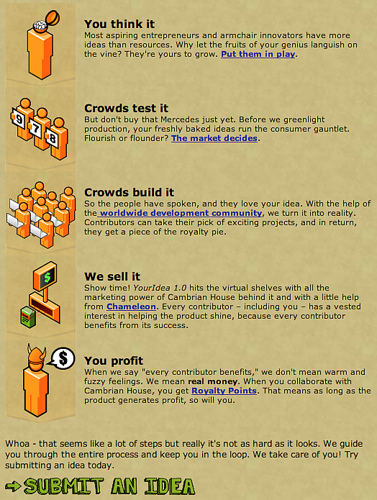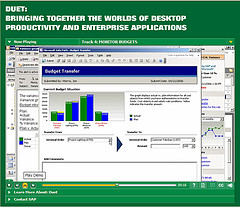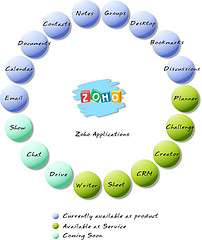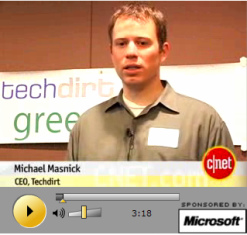Recently my friend, Chris Yeh organized a special SDForum event, “Your Second Best Idea“, where he brought together:
- Creative thinkers who have a killer idea to build a company – if only they had the time
- Entrepreneurial types who’d love to make it happen, but lack the “big idea”
- Venture Capitalists, Angels who would fund it all (?)
Chris’s concept was that after brief idea-presentations the participants would “bid” to team up with the idea owner based on their initial plans to execute and an equity offer to the owner. And if all runs well, perhaps a VC will jump in, too. I had some doubts on how far the process can go in one short event, but it was certainly an interesting experiment. We heard ideas, the crowd discussed them, but we never got to the point of entrepreneurs bidding for the ideas – which somewheat masked the underlying big question:
What’s the value of an idea? In a different context, as part of the NDA discussion I’ve previously stated tha ideas by themselves were not that valuable, it’s the entrepreneur behind the idea that makes or breaks the startup. Well, if that’s true, than how much equity is an idea presented in 5 minutes worth? And if that’s all the idea-owner had, hasn’t he/she just given it away for free?
While the inaugural session did not answer these questions, I’ve recently heard about Canada-based Cambrian House whose entire business model is based on Chris’s concept .. and more. Here’s how they explain it:

So the creative types submit an idea, the community votes (here’s the digg-effect), others will develop it, Cambrina House markets the product. All contributors to this “supply chain” will share the profit, according to a Royalty Point system. All projects start with 1500 Royalty Points, and submitting an idea is worth 75 out of the 1500, so if my math is correct, that’s a 5% equity for the raw idea – pretty high, if you ask me.
![]() What noone can predict for now is whether those Royalty Points will ever get converted to real money, and at what rate.
What noone can predict for now is whether those Royalty Points will ever get converted to real money, and at what rate.
Does Cambrian House have a sustainable business? I have no clue… and I suspect nor do the contributors, or even the Founders of Cambrian. In todays heated entrepreneurial environment apparently being radically different is good enough (and being a serial entrepreneur doesn’t hurt, either), so they landed $2.5M in funding from aptly named Adventure Capital in Alberta, Canada. This funding will go a long way, as they essentially outsourced everything, not paying contributors until profits roll in. I guess we can say their currency is hope:-)
The Cambrians certainly know how to create awareness: in 16 days of existence they had 100K site visitors, there daily reach per Alexa is in the top 100 in Canada. They are not afraid of unusual publicity stunts, although frankly Feeding Google was more about noise than being smart: followed by cameras, completely unannounced, they descended on the Google campus with 1000 pizzas at 3pm. Did you get that? Google, as in Google the company famous for it’s free gourmet food, at 3pm, as in just after luch, before dinner – no wonder they were soon escorted off campus. Cambrian guys, I have a free idea for you: next time set up camp with your 1000 pizzaz at Stanford, you’ll be heroes and won’t leave without 100’s of new ideas…and I don’t even want 75 points, just invite me for the pizza-fest.
![]()
Related posts:
- Cambrian House And “Crowdsourced” Software
- Crowdsourcing and the wisdom of bloggers
- Crowdsourcing : Software
- Ming the Mechanic: Cambrian House
- Cambrian House – Digg for Software Development?
- Cambrian House and Why They Matter
- Shameless Self Promotion
Update (3/23/07): Read/WriteWeb just published an excellent overview of crowdsourcing.



 Well, maybe you shouldn’t. Let me rephrase the original statement: Wikis have arrived when …you don’t even have to know what they are to use one. You don’t have to know you’re using a wiki, just happily type away, creating shareable content on the Web. This just became possible on Monday, with the launch of
Well, maybe you shouldn’t. Let me rephrase the original statement: Wikis have arrived when …you don’t even have to know what they are to use one. You don’t have to know you’re using a wiki, just happily type away, creating shareable content on the Web. This just became possible on Monday, with the launch of 
 The success of traditional conferences largely depends on the quality of the presentations: that’s not the case with the
The success of traditional conferences largely depends on the quality of the presentations: that’s not the case with the 

Recent Comments